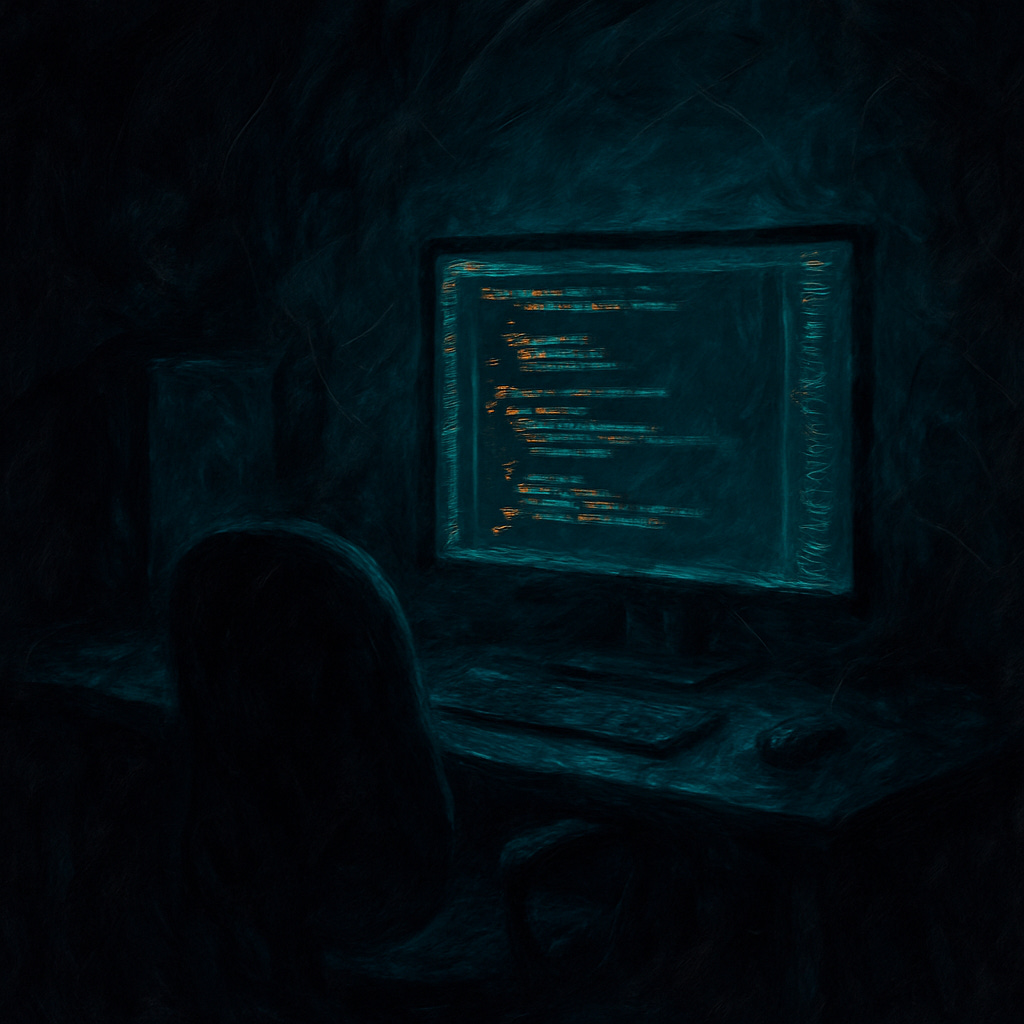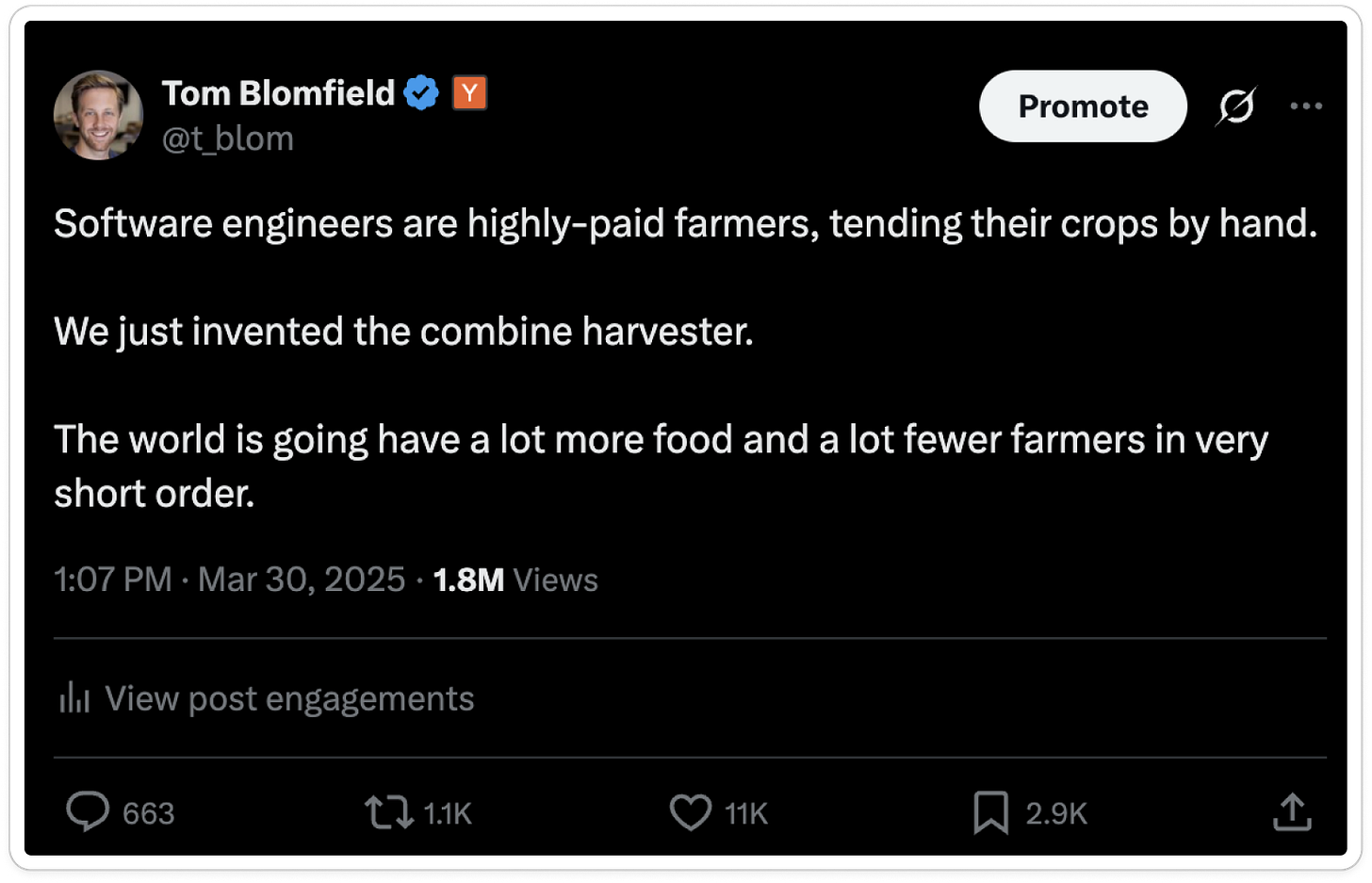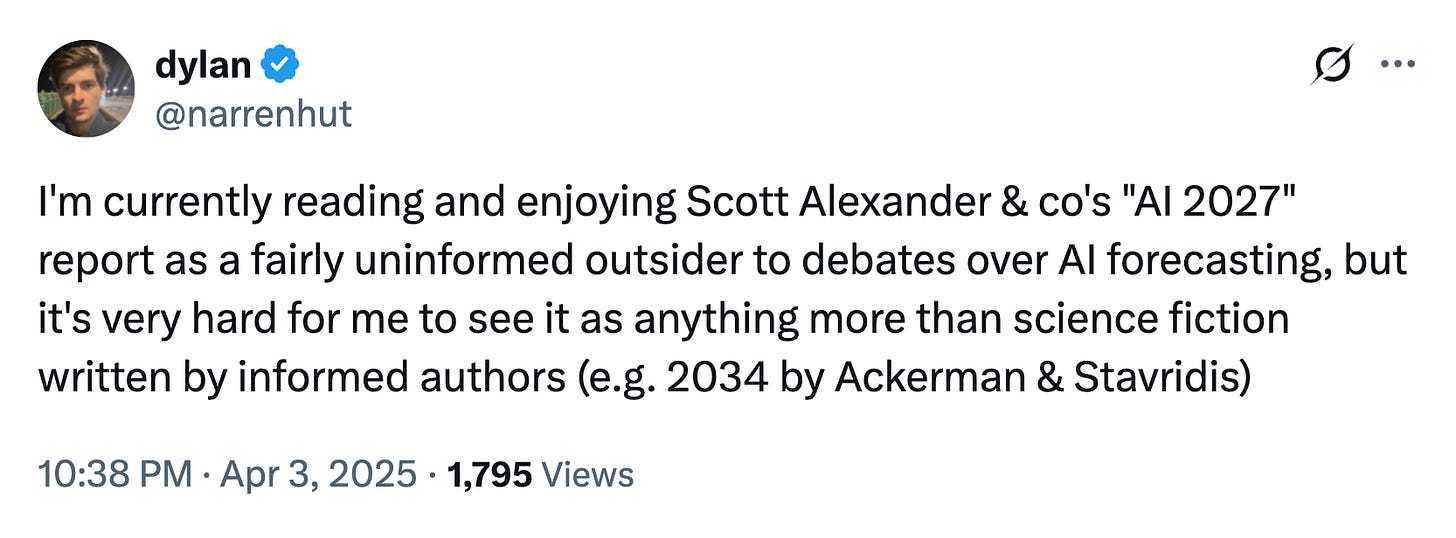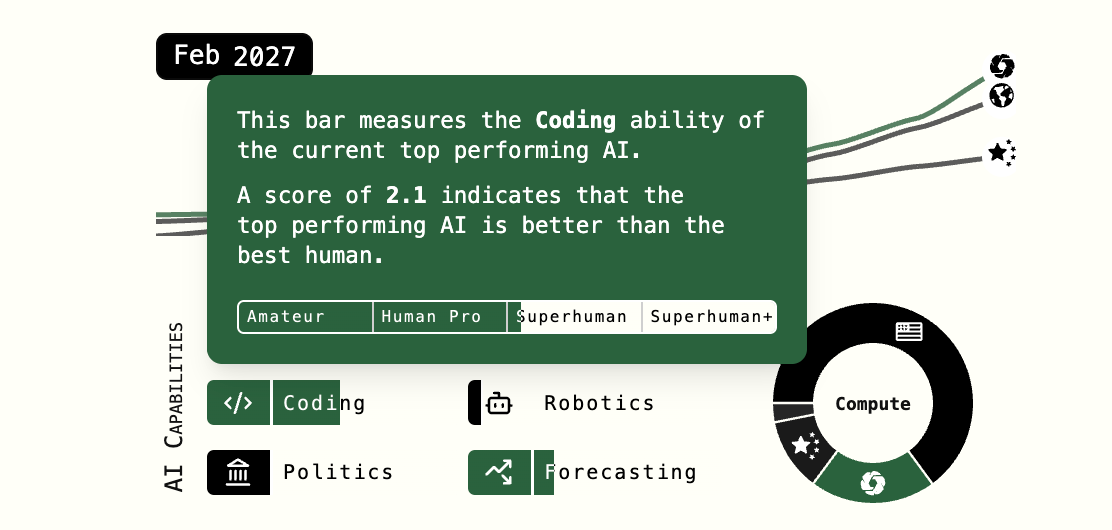Imagining Software in 2027
Does AI 2027 mean we will see the last human commit soon?
It's late 2026. Many people fear that the next wave of AIs will come for their jobs; there is a 10,000 person anti-AI protest in DC.
This isn't science fiction — despite many thinking so, but we’ll get to that later. The snippet is actually a prediction from AI 2027, a forecast paper published earlier this April by a group of AI researchers and superforecasters. It paints a picture of rapid technological progress towards Artificial Superintelligence. A world that many of us might not be prepared for.
How will this world reshape business software? That's what I aim to explore in this essay.
In short, I conclude: By 2027, your company's most valuable software will be built by AI, maintained by AI, and possibly owned by no one.
Seems farfetched? Let's start with why we're collectively unprepared for this rapidly approaching future.
The Unprepared Majority
Technological progress is accelerating rapidly, yet most people remain unprepared for what's coming.
Why are we so unprepared? Three key reasons stand out:
First, there's the comforting but misleading refrain: "Your job won't be taken by AI, but by someone using AI." This idea has been repeated so often that many believe it, but the mid-term reality will likely prove quite different. When AI capabilities cross certain thresholds, the distinction between augmentation and replacement blurs significantly.
Second, AI capabilities are accelerating faster than Moore's Law. We fundamentally struggle to comprehend exponential growth. The human mind tends to extrapolate linearly, while technological progress moves exponentially, creating a persistent cognitive blind spot.
Third, our evaluations quickly become outdated. People who tried and dismissed AI coding tools six months ago need to reassess them today (Footnote: OpenAI’s guidance to developers is actually to expect this cadence to be every two months. That’s how fast things are changing.), but humans rarely update their assumptions at the pace technology evolves. The tools that disappointed last year are unrecognizably better now, yet our perceptions lag behind.
Taken together, most people don't invest enough time understanding AI's capabilities, leaving them blindsided by advances that were clearly coming.
The Superhuman Coding Debate
Even among those who grasp these implications (a distinct minority), most remain in denial or anger phases of adjustment. The reality of what's to come hasn't yet been fully absorbed.
Take for example the debate about superhuman coding capabilities.
Tom writes in his excellent take on it: "My bet is that AI coding agents quickly beat top 0.1% of human performance, at which point it wipes out the need for the vast majority of software engineers."
Remarkably few people believe this today. Most non-technical observers simply don't see it coming, while technical professionals, especially software engineers whose livelihoods depend on coding, don’t want to see it.
Two counterarguments dominate the discussion:
The first argues that LLMs can't (and never will) write real production-grade code. This fundamentally misreads the trajectory we’re on. It's practically inevitable that AI will surpass humans at these jobs given sufficient time, and that timeframe is considerably shorter than most believe.
The second suggests that as coding costs decrease, demand will rise exponentially, actually expanding the total market for software development. While the potential demand for low-cost, high-quality software indeed exceeds current levels, this increased demand will be met by rapidly scaling AI capacity, not human developers.
The AI 2027 paper comes across as science fiction for many, including many of my peers in the tech industry. I don’t want to argue about that today.
For my take on the implications on software, you only need to accept three premises from its forecast:
Superhuman coding will arrive sooner than later, given the intense focus of model providers on this capability.
While agents are practically unreliable today, they will eventually perform most white-collar activities more reliably than most humans.
Model training will become increasingly incremental, with weights updated daily based on new data generated by previous versions.
For this purpose, we can set aside alignment concerns, implications for US-China relations, and other important security considerations (though they're undeniably relevant elsewhere).
A Timeline for Software in 2027
Some caveats before we dive in: I'm neither a recognized superforecaster nor have I collaborated on this with former OpenAI employees. Consider what follows as thinking aloud, either entertaining speculation or thought-provoking material for your own analysis. This isn't about perfect accuracy but about thoughtfully examining potential futures. While this might be irrelevant for 99% of people, founders and investors would do well to consider these possibilities.
Mid 2025: The Era of Imperfect Agents
The autonomous agents flooding the market are theoretically impressive but practically unreliable. Despite their shortcomings, companies deploy them in pilots anyway, pushed by a global economy teetering on recession. Most organizations remain cautious, watching from the sidelines as the early adopters experiment. It's primarily AI-native startups that lead adoption; they have the least to lose and the most to gain. A few established tech companies like Klarna and Shopify make aggressive early moves, earning them both admiration and skepticism from industry watchers.
Late 2025: The AI Arms Race
A flourishing ecosystem of AI-first business software emerges, each applying increasingly sophisticated AI to vertical niches. The seemingly low barriers to entry create a market dynamic where an increasing amount of companies operate in stealth to avoid immediate copycats, while others achieve Cursor-like viral growth through word-of-mouth that competitors struggle to replicate. Venture capital flows abundantly into this space as companies race to outspend their competition, not just on customer acquisition but on access to the most advanced (and most expensive) AI systems and agent technologies.
Early 2026: The Great SaaS Exodus
After the newest model releases, SaaS vendors face their first significant wave of churn as customers discover they can build sophisticated tools in-house with AI assistance and minimal effort. CFOs, who've been looking to trim software expenditures since 2022, enthusiastically champion these initiatives. First to go are point solutions with poor product-customer fit, followed by premium-priced tools that aren't meaningfully evolving, and finally anything that lacks strong data network effects or isn't deeply embedded as a system of record.
This replacement pattern varies by company type. Tech organizations simply build internally. Traditional enterprises turn to newly specialized consultancies and agencies that flourish. While companies typically underestimate initial project costs and complexity, most remain satisfied with their decision to insource, while some 20-30% eventually return to vendor solutions after painful lessons.
Mid 2026: The Continuous Evolution
SaaS companies, facing existential pressure, scramble to innovate with increasingly AI-enhanced offerings. The entire software delivery paradigm has been transformed then, from shelf products (updated yearly at best), to SaaS (updated occasionally), to continuous evolution. This acceleration creates a new problem: customers cannot absorb changes fast enough. The only viable solution emerges where customers no longer interface with software in the traditional sense; the interaction layer must stabilize while underlying systems evolve rapidly.
Meanwhile, early-stage tech companies restructure dramatically around tiny skeleton teams who primarily oversee armies of AI agents handling the bulk of coding and design. Venture funding still flows heavily, but now it goes to startups demonstrating that they can use advanced AIs more effectively than others, a clear shift from the previous narratives of unique human technical talent.
Late 2026: The Silent Displacement
Layoffs of entire engineering teams have become commonplace but receive initially little attention. The public remains preoccupied by geopolitical tensions, political drama, and ongoing conflicts. Additionally, tech layoffs have been so commonplace since 2022 that they barely register as newsworthy. Displaced engineers can still find employment in companies that haven't aggressively adapted to AI, but these safe harbors shrink monthly.
Simultaneously, a growing cohort of AI-empowered indie hackers is building million-dollar businesses as solo founders or tiny teams. Most operate in relative obscurity, having learned that visibility attracts both copycats and attacks. The only indie hackers maintaining public profiles are those selling directly to their own audiences while treating individual projects as disposable components in a broader portfolio strategy.
January 2027: The Self-Learning Revolution
Leading AI development tools now incorporate live internet access. New ideas, features and entire products are reverse-engineered within minutes or hours of their announcement. Traditional businesses remain hesitant to fully embrace these or other agentic AI systems; employee fear of replacement creates significant cultural resistance to adoption.
In this gap, a new breed of AI-first service companies emerges, predominantly newly-founded ventures gaining market share through both organic growth and strategic M&A tactics. Their economics defy traditional categorization; some enjoy software-like margins despite providing services, while others deliberately operate at service-like margins to aggressively expand their customer base.
March 2027: The Architectural Paradigm Shift
A fundamentally new paradigm of software architecture crystallizes. The assumptions about application structure have evolved to accommodate AI at every layer of the stack. Late adopters discover an unexpected advantage; they can build directly on these new foundations rather than retrofitting AI onto existing architectures. These late movers begin producing high-performing AI products that outcompete earlier attempts from pioneers now struggling with first-generation AI architectures.
July 2027: The End of Programming as We Know It
The investment community, desperate to participate in the AI revolution, pours billions into AI wrapper startups across sectors. The market for new programmers has collapsed; computer science enrollment begins dropping as students pivot to fields perceived as more AI-resistant. Paradoxically, there has never been a better time to be a consultant specializing in AI integration and strategy.
The software landscape undergoes an explosion with new applications emerging daily. For almost every white-collar profession, multiple well-funded startups now promise complete AI-driven disruption. The most profound shift happens quietly as AI agents take over entire operational functions within companies, starting with customer service, expanding to outreach and back-office tasks, and eventually handling procurement decisions by negotiating directly with other AI systems.
October 2027: A Two-Tier Software Economy
A bifurcated market emerges. The most advanced AI systems become accessible only through closed networks driven by word of mouth. Companies utilizing these systems must sign strict NDAs to prevent innovations from leaking to the broader internet, where increasingly capable AI agents would immediately replicate and disseminate them.
Standard white-collar tasks such as sales prospecting, marketing copy creation, and basic analytics become largely automated. Previously fragmented SME markets begin mirroring the winner-take-all dynamics of technology markets, governed by power laws rather than geographic constraints. The most valuable companies are those orchestrating AI capabilities rather than those directly employing the humans being replaced.
Tldr; Exciting years ahead
The coming years will be equally exciting and exhausting for founders and investors. We will see a fundamental restructuring of how software is built, deployed, and updated.
Companies that recognize these shifts early and position themselves accordingly will thrive in the new landscape. This means preparing for a world where:
Agents might be most of a software’s user base.
Human teams become dramatically smaller.
The line between service businesses and software companies blurs completely.
The question isn't whether these changes are coming, but how quickly we adapt to them. The timeline I've outlined might seem aggressive, but timelines aren’t my main point. Even if we overestimate short-term impact, we might underestimate long-term impact. We’re in for a wild ride.
Thanks to Viet Le and Gloria Bäuerlein for feedback on early versions of this post.







@Christian Eggert - if you were a betting man - caveats accepted vis-a-vis not being a super forecaster- any particular SaaS company you would predict being amongst the first to be seriously challenged by the new AI driven business models?